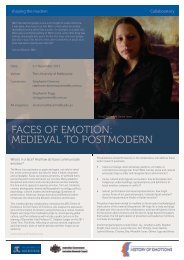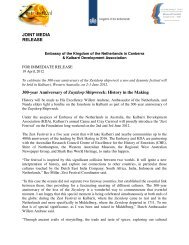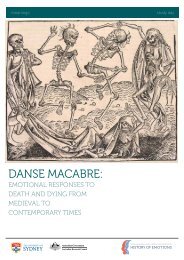Download our K-12 education pack - ARC Centre of Excellence for ...
Download our K-12 education pack - ARC Centre of Excellence for ...
Download our K-12 education pack - ARC Centre of Excellence for ...
Create successful ePaper yourself
Turn your PDF publications into a flip-book with our unique Google optimized e-Paper software.
stories <strong>for</strong> teachers & students 2013<br />
Supporting Res<strong>our</strong>ces<br />
South Africa, Far from Home<br />
stories by winthrop pr<strong>of</strong>essor susan broomhall<br />
Image/ Albert Pinkham Ryder, Der vliegender Holländer, 1887. Copyright Smithsonian American Art Museum.<br />
the sailors; and, on their relating the circumstances when they<br />
arrived in port, the story spread like wild-fire, and the supposed<br />
phantom was called the Flying Dutchman. From the Dutch the<br />
English seamen got the infatuation, and there are very few<br />
Indiamen, but what has some one on board, who pretends to have<br />
seen the apparition.”<br />
Barrington didn’t think much <strong>of</strong> the legend clearly, but the story<br />
captured the imagination <strong>of</strong> Sir Walter Scott who picked it up and<br />
published it in Blackwood’s Magazine in 1821. He gave the captain<br />
a Dutch name, Hendrick van der Decken, and made him ‘a<br />
staunch seaman, and would have his own way in spite <strong>of</strong> the devil.’<br />
at making the j<strong>our</strong>ney from The Netherlands to Batavia was a<br />
marvel to contemporaries. In 1678, he made the j<strong>our</strong>ney in just 3<br />
months and 4 days. This caused people to wonder how he did it,<br />
and some rum<strong>our</strong>ed that he must have made a deal with the<br />
devil to assist him.<br />
So, from ropes and knots to tattoos and ghost ships, sailors have<br />
created many stories, legends and phrases that appear in <strong>our</strong><br />
everyday language today. These tall tales and ritual practices<br />
with rope reflect the hopes and fears <strong>of</strong> sailors and the many<br />
dangers that they faced in uncertain j<strong>our</strong>neys across the globe.<br />
The story is this: that in doubling the Cape they were a long day<br />
trying to weather the Table Bay. However, the wind headed them,<br />
and went against them more and more, and Van der Decken<br />
walked the deck, swearing at the wind. Just after sunset a vessel<br />
spoke him, asking him if he did not mean to go into the bay that<br />
night. Van der Decken replied: ‘May I be eternally damned if I do,<br />
though I should beat about here till the day <strong>of</strong> judgment. And to<br />
be sure, he never did go into that bay, <strong>for</strong> it is believed that he<br />
continues to beat about in these seas still, and will do so long<br />
enough. This vessel is never seen but with foul weather along<br />
with her’.<br />
The origins <strong>of</strong> Scott’s van der Decken character seem to date<br />
back to a VOC captain, Barend Fockesz. whose remarkable speed<br />
FAR FROM HOME: ADVENTURES, TREKS, EXILES & MIGRATION<br />
45












